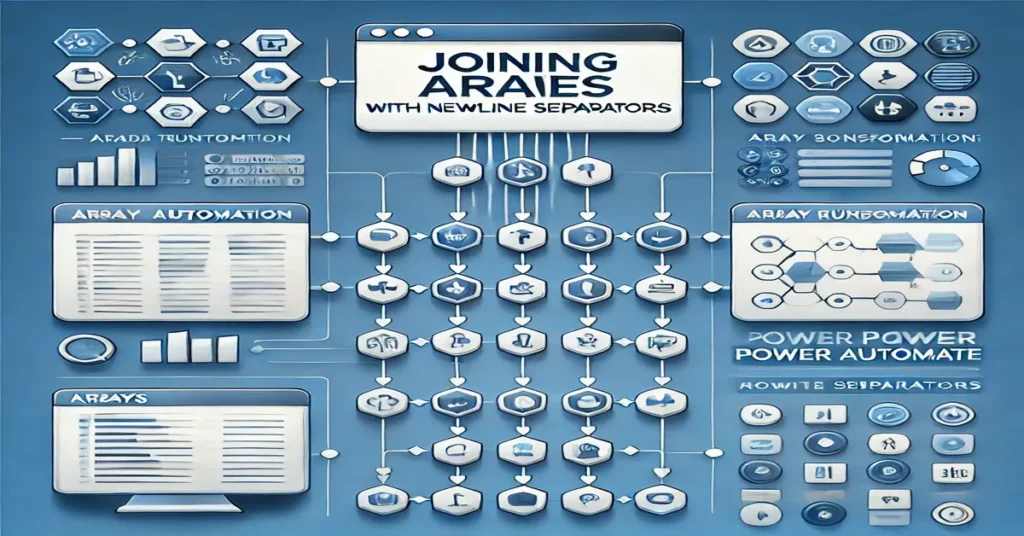power automate join array newline separator tool in the Microsoft Power Platform suite, designed to automate workflows between your favorite apps and services. One common use case involves manipulating arrays—an essential operation in scenarios ranging from data processing to generating formatted outputs.
In this article, we’ll delve into how to join arrays in Power Automate with a newline separator. We’ll discuss its significance, the steps involved, use cases, and advanced tips to help you optimize your workflows. Finally, we’ll address common questions to clarify this process further.
Understanding Arrays in Power Automate
What is an Array?
An array is a data structure consisting of a collection of values, called elements, each identified by an index. In Power Automate, arrays are commonly used for handling data such as lists of items, rows of a table, or multiple pieces of information derived from an external source.
The Role of Array Operations
Operations on arrays, such as filtering, joining, and transforming, are critical to ensure that the data format aligns with the requirements of subsequent steps in your workflow.
The Join Operation
What Does “Join” Mean?
The join function in Power Automate is used to concatenate the elements of an array into a single string, using a specified delimiter. A delimiter can be any character or string that separates the joined elements.
Why Use a Newline Separator?
A newline separator (\n) is especially useful when you want the joined elements of an array to appear on separate lines. This is helpful in scenarios such as:
- Formatting email content
- Creating logs or reports
- Preparing data for multi-line text fields
Step-by-Step Guide to Joining Arrays with Newline Separator
Here’s how you can join an array with a newline separator in Power Automate.
Step 1: Prepare Your Array
Ensure your workflow generates or contains an array. This could be fetched from:
- A SharePoint list
- An Excel table
- A database query
- A manual input
Step 2: Use the Join Function
- Add a Compose action or another action where you can define an expression.
- Use the following expression:plaintextCopy code
join(variables('YourArray'), '\n')Replace'YourArray'with the name of your variable or array.
Step 3: Configure Output
The result of this operation will be a single string where each array element is separated by a newline. You can store or use this output in:
- An email body
- A text file
- A SharePoint list item
Example Expression:
plaintextCopy codejoin(outputs('Get_items'), '\n')
Step 4: Test and Debug
Run your workflow and check the output. If any issues arise, verify:
- The array structure
- The action where the array is defined
- The syntax of your join expression
Common Use Cases
1. Formatting Emails
Using a newline separator to list array elements makes emails more readable. For example:
- Items purchased in an order
- Pending tasks in a project
2. Generating Logs
Logs that list items or operations are more organized when array elements are separated by newlines.
3. Data Transformation
Prepare data for systems or APIs that require multi-line text input.
4. Reports and Summaries
When automating reports, using newlines enhances clarity for fields like:
- User feedback
- Survey results
Advanced Tips
- Handle Empty or Null Values: Use
filterbeforejointo exclude empty or null values:plaintextCopy codejoin(filter(variables('YourArray'), item() != ''), '\n') - Customize Delimiters for Mixed Formatting: Combine newlines with other delimiters:plaintextCopy code
join(variables('YourArray'), ',\n') - Dynamic Inputs: If the array is dynamically fetched, ensure proper error handling to manage cases where the array might be empty.
- Apply Conditions: For conditional joins, consider using
ifexpressions:plaintextCopy codeif(length(variables('YourArray')) > 0, join(variables('YourArray'), '\n'), 'No items found.') - Combine with HTML Tags: For formatted emails, replace
\nwith<br>to produce line breaks in HTML:plaintextCopy codejoin(variables('YourArray'), '<br>')
Challenges and Solutions
Challenge 1: Array Contains Complex Objects
Arrays often contain objects with multiple properties. Use the select function to extract specific properties:
plaintextCopy codejoin(select(variables('YourArray'), item()?['PropertyName']), '\n')
Challenge 2: Large Arrays
For arrays with thousands of elements, ensure your workflow doesn’t hit performance limits. Break large arrays into chunks using chunk logic.
Challenge 3: Compatibility with Downstream Actions
Verify that the downstream action supports newline-separated strings. If not, consider alternative formats like JSON.
Conclusion
Joining arrays with a newline separator in Power Automate is a straightforward yet powerful operation. It allows for seamless data formatting, especially in workflows requiring clean and organized outputs. By understanding the nuances of arrays and mastering the join function, you can enhance the efficiency and readability of your automated workflows.
FAQs
1. What is the syntax for the join function in Power Automate?
The syntax is:
plaintextCopy codejoin(array, delimiter)
Replace array with your array variable and delimiter with the desired separator.
2. How do I handle empty elements in my array?
Use the filter function to remove empty or null values before joining:
plaintextCopy codejoin(filter(array, item() != ''), '\n')
3. Can I use multiple delimiters in the join function?
Yes, combine delimiters in the expression. For example:
plaintextCopy codejoin(array, ',\n')
4. What happens if the array is empty?
The join function will return an empty string. You can handle this scenario using a condition:
plaintextCopy codeif(empty(array), 'No items found.', join(array, '\n'))
5. Can I use \n in HTML emails?
Replace \n with <br> to produce line breaks in HTML-formatted emails.
6. Are there any size limits for arrays in Power Automate?
Yes, Power Automate has performance limits. For large arrays, consider breaking them into smaller chunks or paginating the results.
This comprehensive guide ensures you have the knowledge and tools to join arrays with newline separators effectively in Power Automate!







